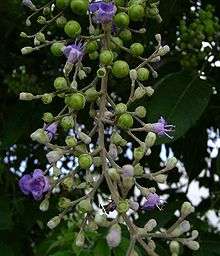Vitex trifolia
Vitex trifolia, the simpleleaf chastetree,[1] is a large coastal shrub or small tree.[2]
| Vitex trifolia | |
|---|---|
 | |
| leaves, seeds (left), flowers (right) | |
| Scientific classification | |
| Kingdom: | Plantae |
| Clade: | Tracheophytes |
| Clade: | Angiosperms |
| Clade: | Eudicots |
| Clade: | Asterids |
| Order: | Lamiales |
| Family: | Lamiaceae |
| Genus: | Vitex |
| Species: | V. trifolia |
| Binomial name | |
| Vitex trifolia | |
Description
Vitex trifolia is a large coastal shrub or small tree, less than 5 m in height with the stems covered by soft hairs (tomentose). The leaves are oppositely arranged along the stems and are usually compound, composed of 3 linear leaflets which range between 1 –12 cm in length. The upper surface of the leaves are green and the lower surface grayish green.
The flowers are born in panicles or clusters up to 18 cm in length. Individual flowers have purple to violet two-lipped corollas that are approximately 5 mm long. The stamen are in two pairs and the ovary is superior, or develops above the corolla. The fleshy fruits are about 6 mm in diameter and contain 4 small black seeds.
Distribution
Vitex trifolia is naturally found along coastlines from tropical East Africa as far east as French Polynesia.
Traditional medicine
The leaves are used to treat female ailments in the Cook Islands, and used to relieve fever in Samoa. Additionally in Samoa, the dried leaves are burned to deter mosquitos.
Indigenous names
- Seychelles - Bois noux noux
- Cook Islands - rara
- Tonga - lalatahi
- Samoa - namulega
- India:[3]
- Indonesia
- Indonesian - Legundi -> Dutch: Legoendi
- Bali - Liligundi
- Bugi - Lawarani (ᨒᨓᨑᨊᨗ)
- Philippines - Lagundi, Halamang gamot.
- Malaysia - Lemuni (especially in northern region)
References
- "Vitex trifolia". Natural Resources Conservation Service PLANTS Database. USDA. Retrieved 6 August 2015.
- "GRIN Species Records of Vitex". Germplasm Resources Information Network. United States Department of Agriculture. Retrieved 2010-12-12.
- Vitex trifolia, Dr. K.M. Nadkarni's Indian Materia Medica, by A.K. Nadkarni, Popular Prakashan, Bombay, 1976, pp: 1281-2.